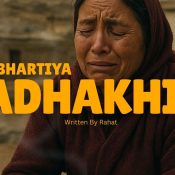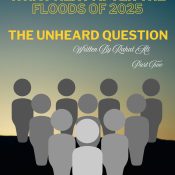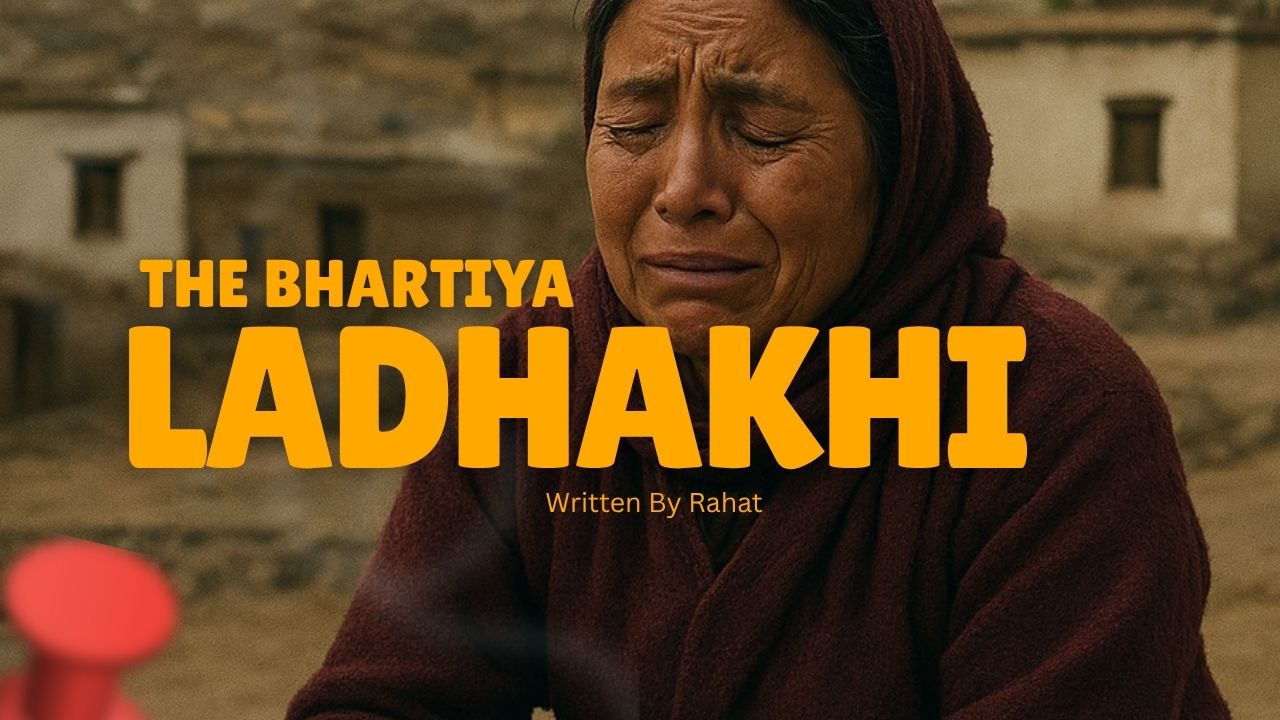
The Bhartiya Ladhakhi:Echoes From The Roof Of The World
“In the silence of the mountains, the loudest cries are those unheard by the world.”
Written By Rahat
Published By:The Uncommon Stories Of India
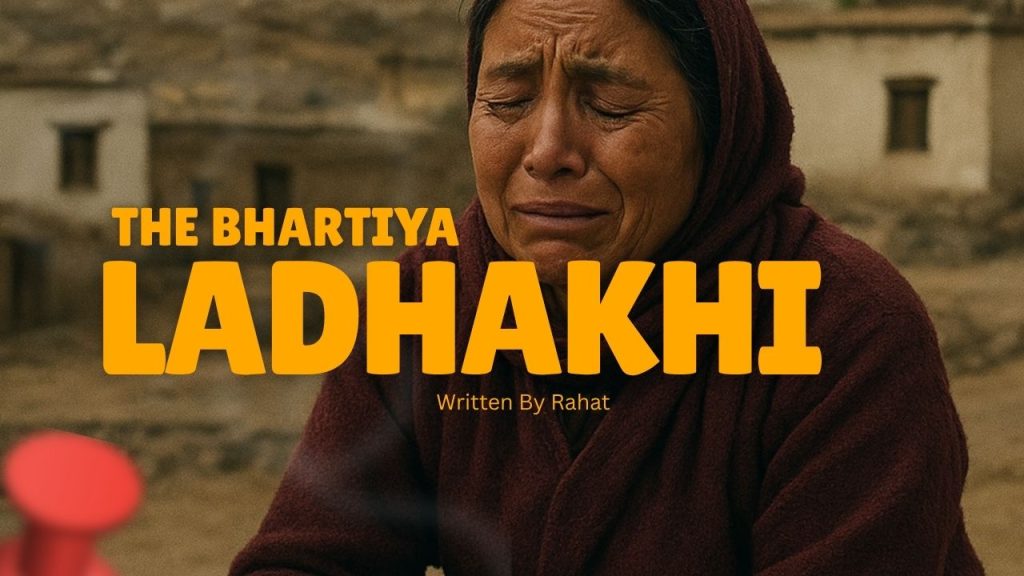
I arrived in Ladakh under a sky so clear it seemed unreal, a shade of blue that hurt the eyes with its purity. The mountains rose around me, stoic and eternal, but the faces of the people here told a story that the mountains could not absorb. I walked through the streets of Leh and Kargil, and it was in those streets, in the quiet corners and shuttered markets, that I began to see the truth that no report, no news clip, could ever convey.
The eyes of the people met mine first. Eyes that had witnessed more pain than they had words to describe. Some were hollow, emptied by grief, yet flickers of stubborn resilience danced within them. Others were red-rimmed, streaked with tears that refused to be shed in public, holding back the storm of sorrow for fear of being seen as weak. There was fear in the silence, a tension that hovered over every conversation, every step. And there was anger, too—not the loud, explosive anger of mob protests, but the quiet, simmering, consuming anger of people who feel unseen, unheard, betrayed.
I listened as they spoke softly, haltingly, often more to themselves than to me. Their voices trembled, not just with emotion, but with the fatigue of bearing the unbearable. “We had our lives here,” one whispered, almost afraid to be heard, “our work, our children, our peace… taken in a night.” Another muttered about the future, about the children, about the dreams that now seemed like fragile paper floating over an abyss. The stories were not always linear, not always coherent—they were fragments of memories, of losses, of fear—but each fragment carried the weight of entire lifetimes.
I watched mothers clutching their scarves tighter, as though to hold themselves together. Fathers gazing into the distance, lost in memories of calm days that felt like a lifetime ago. The young ones—some barely out of adolescence—stood stiffly, faces set, hiding trembling hands and racing hearts, pretending for everyone else’s sake that they were unaffected. And yet, at night, in the darkness of their rooms, away from all eyes, I imagined the screams they let out, the tears they could not hold back, the questions that tormented their minds.
There was a soundless grief here, a grief that did not announce itself but saturated every gesture. I saw it in the hands of an old woman, the fingers curling around a prayer bead as if it could ward off reality. I saw it in the stance of a young man who refused to lower his gaze, even as his body trembled with exhaustion and fear. I saw it in the children, whose laughter had grown hesitant, whose smiles had become rare, like fragile buds braving the frost.
What struck me most was the duality. Alongside the despair, there was an undeniable resilience. A stubbornness to endure, to exist, to hope, however faintly. They spoke of continuing their work, of teaching, of tending their animals, of rebuilding what was lost—though none knew exactly how to do it. There was a sense of defiance in that hope, not loud, not confrontational, but quiet and unyielding. Even the tear-streaked faces bore a dignity that refused to break entirely, a message to the world that they would not vanish quietly.
I spent hours in a small market square, observing without intrusion. Vendors hesitated to call out to potential customers, yet their eyes tracked me with a cautious curiosity. Children played nearby, their games muted, a ball rolled slowly across dusty stones, laughter broken by sudden silences. I overheard snatches of conversation, fragments that burned into my mind: “Why do they forget us so easily?” “We live under shadows now, not the sun.” “The mountains watch us cry, but who listens?”
At night, I walked through the narrow lanes, guided by dim lamplight. The air was cold, biting, yet it carried with it the scent of earth, smoke, and something undefinable—loss. Windows glowed faintly, revealing families gathered around small fires, whispering prayers, recounting stories, clinging to one another in a way that seemed both desperate and sacred. I felt the weight of their solitude, their isolation from the larger world that would continue without noticing. And I felt the heaviness of unspoken words—words that carried fear, sorrow, but also an unwavering demand: “See us. Hear us. Know that we live and suffer here, in these mountains, even if no one else does.”
The nights were the hardest, I realized. In dreams, the people relived the incident, over and over, each replay accompanied by a different terror. Some dreamt of sudden chaos, of loved ones disappearing in the blur of smoke and confusion. Others dreamt of silence, a silence so deafening it pressed against their ears until reality and nightmare blurred. I could feel these dreams even in the waking moments, in the way mothers flinched at sudden noises, in the way fathers hesitated before opening doors, in the way children hesitated to speak, as though fear could be passed through words.
And yet, even in their pain, they found ways to communicate hope. A small act of kindness—sharing a warm meal, helping a neighbor—was elevated to profound significance. Every smile given despite fear was a victory. Every prayer uttered, every whispered wish for justice and peace, was a rebellion against despair. The mountains had always seemed eternal, immovable, but now they also seemed protective, cradling these fragile lives, giving them space to grieve and endure.
There is something I will never forget: the silence after the storm. Not emptiness, but a quiet filled with intensity. It is the silence of people who have survived terror, who have lost much, yet cling to what remains. It is the silence of those who demand the world to pause and acknowledge their pain, not through protests or slogans, but through the simple, human act of being present and visible. It is the silence that screams louder than any chaos, louder than any headline, louder than any political rhetoric.
I leave this part here, as it sets the tone and atmosphere. The next parts will continue to explore their inner monologues, daily struggles, their cautious interactions with outsiders, and how the incident has transformed the very essence of their lives—capturing.
I walked further into the valleys, where the sunlight struggled to reach through the high cliffs, and the wind carried whispers that seemed almost like voices. It was here that the weight of what had happened settled fully in my chest. I could hear the thoughts of the people, though unspoken: “Will the world remember us tomorrow? Will our tears be counted?” They moved through their daily routines, milking animals, tending fields, repairing homes—but each action was shadowed by the memory of that night. Every creak of a door, every distant shout, every passing vehicle stirred old fears.
I watched an elder woman sitting outside her house, her hands folded in her lap. She did not cry openly, yet the tightness around her mouth and the distant look in her eyes told me she had cried enough for generations. She whispered to herself, repeating prayers that had been passed down for centuries, yet her voice carried the tremor of someone who no longer believed that the prayers would change anything. And still, she prayed. That was the resilience I could not stop observing—the act of living, of hoping, in defiance of despair.
The young men were different. Their anger was simmering, restrained, but visible in small ways: a tightened jaw, a hard set of the shoulders, a glare that lingered longer than politeness required. Some spoke in fragments, sharing fears about their future: “What if we cannot study? What if our families are torn apart?” They were afraid, yes, but their fear was mixed with determination. They spoke of learning, of working, of preserving their identity, even if the outside world seemed indifferent.
Children were perhaps the most heartbreaking. I saw them carrying the echoes of terror they could not name. They drew pictures on scraps of paper, not of mountains or rivers, but of shadows, of people disappearing, of homes burning in their imaginations. Their laughter was hesitant, their games cautious. When they smiled, it was fleeting, as though the muscles in their faces were learning to remember joy after long disuse. One little girl hid behind her mother when I approached, her tiny hands clutching a doll that seemed to absorb her fear. I could sense the questions swirling inside her mind: “Why did this happen? Why do we feel so small in a world so vast?”
Food had lost its taste for many. In homes, meals were shared quietly, silently, the act of eating transformed into a ritual of survival rather than enjoyment. Conversations circled around necessities, not dreams. “We must save what little we have,” I heard whispered repeatedly. But even in such a small town, rumors spread like wildfire, adding weight to every decision. Every stranger, every official, every outsider carried the potential to bring more grief or relief. Trust had become a precious, rare commodity.
The nights were the hardest. The wind howled through narrow alleyways like voices from the mountains themselves, sometimes sounding like cries, sometimes like laughter that had gone wrong. People slept in shifts, in shared rooms, or sometimes not at all. Dreams became a battlefield. They dreamt of loss, of betrayal, of sudden violence, of loved ones vanishing in thin air. And yet, they also dreamt of justice, of reunions, of sunlight spilling over valleys untouched by sorrow. The contrast made waking all the more jarring. A single shadow outside a window would startle even the oldest, most stoic residents.
I tried to speak to some of them, but often my questions seemed trivial, or even intrusive. How could I ask, “How do you feel?” when each word carried layers of pain that could not be simplified? Instead, I listened, noting the pauses, the hesitation, the sighs that filled the air between words. I saw mothers humming softly to calm themselves, fathers muttering protective curses to keep fear at bay, teenagers drawing strength from each other, holding hands in streets that had suddenly become dangerous. Each gesture was a testament to endurance. Each whispered breath carried a message: “We live. We endure. We hope, quietly.”
In the quiet moments, I imagined their internal dialogues. They spoke in a language not meant for outsiders, a language of raw emotion: “I cannot lose hope. But if hope fails, what is left? Will we ever be safe? Will the world know our suffering?” I realized that the pain was not just for the past incident—it was compounded by years of neglect, of being overlooked, of being treated as if their remote lives were inconsequential. Every tear, every sigh, every fearful glance was a reminder of that invisibility.
Even when I ventured outside the main towns, the villages carried the same silent intensity. Small houses perched precariously along rocky slopes, with families clinging to each other as though the earth itself might betray them. I watched a father teaching his son to repair a fence, both of them whispering, careful not to draw attention. The son’s hands shook not from inexperience but from the anxiety that had become a constant companion. The father’s eyes darted to the horizon, listening, imagining dangers in every sound. And yet, they worked, spoke, and laughed quietly—the human spirit persisting in the narrowest spaces.
The environment itself seemed to mourn with them. Rivers that had once sparkled with crystalline clarity now seemed heavy, carrying the weight of sorrow through the valleys. The mountains, usually aloof and eternal, now felt like witnesses to unspoken tragedies. At dawn, the sunlight would illuminate fields that had been tended with care, yet the beauty of the landscape did little to ease the heaviness of the heart. There was no escape from the knowledge that life could change in an instant, and the past, no matter how treasured, offered little solace.
And still, hope survived, fragile and tenacious. It was in the small acts: sharing a blanket with a neighbor, offering a few pieces of bread to a passing child, a prayer whispered over a fire. It was in the way families held together despite fear, in the way the young refused to let terror shape their every step. They spoke not of revenge but of endurance, not of fury but of justice. The message they carried was subtle yet unyielding: “See us. Hear us. Remember us.”
The days here had a rhythm that outsiders could barely understand. Sunlight moved slowly across the jagged mountains, casting long shadows that seemed to follow the people everywhere they went. I noticed how every movement, every gesture, carried layers of meaning. A simple nod could signify agreement, understanding, or even silent mourning. A glance toward the horizon could carry fear or hope, sometimes both simultaneously. In this land, where the air itself was thin and harsh, every breath seemed to weigh more than it should.
I walked along a narrow path where women were carrying water in clay pots. Their pace was slow, deliberate, as if each step demanded careful calculation. I could see the tension in their shoulders, the tight grip on the pots. Yet, in their eyes, there was also a quiet pride, a refusal to let fear paralyze them. They whispered to one another, sharing fragments of worry and solace. I could not hear all their words, but I felt the weight of them—the shared burden of a community that had endured so much and would endure more.
In the marketplace, I observed a man repairing a roof, his hands blackened with soot and calluses. He paused to rest, and in that moment, I saw the layers of his inner world. His eyes carried sleepless nights, memories of chaos, and an unspoken longing for normalcy. Yet, he returned to work, hammer in hand, because survival demanded it. His labor was not just about fixing a roof; it was about holding onto dignity in a world that seemed intent on erasing it.
Children played in the distance, and their games were filled with both innocence and caution. A ball bounced slowly across the stones, laughter hesitant and fragile. When one of the children tripped, a small hand reached out to help, and I saw the first lessons of resilience being quietly taught. These children were learning that even when the world seems harsh and unjust, small acts of care and connection mattered—they were threads that could bind a community fraying at the edges.
Nightfall brought a different kind of intimacy. Families gathered around small fires, sharing warmth and quiet conversation. I could hear whispered stories of loss and survival, tales of nights when fear gripped them like a living thing. They spoke of the incident, not in anger, but in careful remembrance, like scholars reciting lessons from a book they never wanted to read but could not forget. Each story carried pain, yet also subtle hints of hope—proof that memory alone could not extinguish the human spirit.
I watched an elderly man staring at the horizon, his hands folded in his lap. I imagined his thoughts: “The world moves on. It forgets. But I will not. I have seen too much, felt too much to let it vanish.” There was a quiet defiance in that. I understood that for these people, remembering was not just a duty; it was a form of resistance, a way of asserting that their suffering, their lives, and their identity mattered.
I spent hours listening to conversations that never fully reached the surface. There were pauses, glances, incomplete sentences, all heavy with meaning. A mother spoke of her son’s future, her voice trembling not because of fear alone, but because she feared that hope itself might be fragile. A father muttered about the mountains, about their history, about the patience required to endure. Young men and women spoke in careful tones about education, work, and the small victories that seemed to matter more now than ever.
The nights were punctuated by dreams, both personal and collective. Some dreamed of chaos repeating itself, of sudden violence that could strike without warning. Others dreamed of being lost in endless valleys, searching for loved ones, their cries unheard. Yet, even in dreams, there were glimmers of hope—sunlight breaking through clouds, rivers flowing pure again, laughter echoing without fear. These dreams were reminders that even the subconscious refused to surrender entirely, and that hope, however fragile, remained embedded in the psyche of the people.
I noticed small rituals of comfort and survival. Families held hands tightly during meals, even if they did not speak. A child hugged a favorite toy close, whispering reassurances. A neighbor shared firewood or water, wordlessly bridging the gaps between fear and care. Every act, no matter how mundane, carried profound significance. In a land overshadowed by uncertainty, these gestures became symbols of continuity, of life persisting despite adversity.
There were moments when the pain surfaced visibly. I saw tears in eyes that had long resisted crying, hands shaking as grief became too heavy to bear silently. And yet, there was dignity in their sorrow—a refusal to let suffering become spectacle. It was private, intimate, and all the more powerful for it. The mountains, ever watchful, seemed to absorb these sorrows, yet I knew that no landscape, no matter how grand, could carry the full weight of human anguish.
What struck me most was the duality within each person: the coexistence of despair and hope. Even as they recounted horrors, they spoke of dreams, of resilience, of survival. They had learned to walk forward while carrying the past, to live while holding grief in their hands like a fragile lamp. And in that coexistence, I felt the pulse of a community that refused to break, a society that had been tempered in pain but remained unbowed.
The mountains themselves seemed to carry the weight of memory. Walking through the narrow paths between cliffs, I could feel the silence pressing in on every side. There were moments when the wind seemed to speak in hushed tones, as if recounting the stories it had witnessed for centuries. I imagined the mountains listening to the people’s grief, absorbing it into their stoic faces, yet offering no answers. And perhaps that was what made the people of Ladakh so extraordinary—they had learned to speak to the mountains, to let the landscape witness their pain, even when the world could not.
Inside homes, the air was heavy with quiet contemplation. I observed families gathered in low-lit rooms, the flicker of oil lamps casting shadows across faces lined with worry. Conversations moved slowly, as if each word might awaken something too painful to bear. They spoke not just about what had happened, but about what it meant—the fragility of life, the unpredictability of the future, the weight of being ignored by those far away. And yet, amid these reflections, there were fragments of hope. A small laugh shared between siblings, a comforting hand on a shoulder, a quiet promise whispered into the darkness.
The children carried the deepest imprint of fear. I watched them sitting by the side of the road, their eyes wide and observant, taking in every detail, measuring every movement. When they spoke, it was in cautious tones, words measured, questions half-formed. “Will it happen again?” they asked quietly, almost to themselves. Their parents answered with gentle reassurances, but the tremor in their voices betrayed the knowledge that such reassurances were fragile, thin as the mountain air. I thought of how these children would carry the events with them for years, how their dreams and nightmares would intertwine with the memory of loss.
Even young adults bore the scars in ways subtle but undeniable. A glance could reveal sleepless nights; a pause could hide racing thoughts. Some moved with deliberate care, as if every step might trigger memories better left untouched. Others carried an unspoken resolve, their minds fixed on preserving what little they could control. The duality of fear and determination was constant, almost a living rhythm in every interaction. These were people who had faced sudden loss and had learned that endurance was both a shield and a weapon.
I walked past fields that had once been vibrant with color, now muted under the weight of collective sorrow. Farmers moved slowly, attending to the earth with hands that trembled slightly, carrying grief that had no outlet. They spoke occasionally of seasons past, of crops that had thrived, of children who had run freely across these fields. And then their voices would falter, caught between remembering and confronting the present. It was clear that for them, life itself had become a delicate act of balancing between past joys and current fears.

The nights brought a different intensity. The wind, high up in the valleys, carried echoes that were almost voices—voices of absence, voices of lost friends and family, voices of the world they longed for but could not reach. Sleep was thin, fragmented, and filled with visions of what had been taken. And yet, even in the darkness, there were moments of light. A child’s soft breathing beside a parent, a whispered prayer that trembled in the silence, a small act of courage that went unnoticed. These small gestures became symbols, subtle markers that life, though altered, would persist.
I began to notice patterns in their behavior that outsiders might miss. Doors were left slightly ajar, but not fully open—a measure of caution. Conversations often shifted to mundane topics quickly, avoiding emotional depths until trust had been carefully measured. Shared meals were deliberate, a way of maintaining connection despite fear. And yet, beneath all of this was a quiet insistence on existence, a refusal to let terror define their lives entirely. Every measured step, every whispered word, every cautious laugh was a statement: “We are here. We endure. We continue.”
The connection between the people and the landscape was undeniable. Mountains were both shelter and witness. Rivers were both lifeline and silent recorder of sorrow. I saw people speaking to their environment, sometimes aloud, sometimes in thought, asking for guidance, strength, or simple acknowledgment. The land, in its vastness, reflected the enormity of their internal struggles—immovable, harsh, beautiful, and indifferent. Yet this environment also offered a strange comfort. To endure the mountains was to endure life itself. And in enduring, there was dignity.
Even as the days passed, and the immediate chaos faded into cautious routine, the memories remained sharp. Every sudden sound, every unfamiliar shadow, could trigger a moment of panic. But these reactions were tempered by resilience. People learned to navigate their environment and each other with care, to protect one another while acknowledging the fragility of their own hearts. They built invisible shields, structures of trust and vigilance, woven from shared experience and mutual understanding.
I realized that this was the essence of their struggle: living with constant awareness of vulnerability, yet refusing to surrender to despair. Every act—feeding animals, tending fields, walking through the market, whispering prayers, holding a child’s hand—was imbued with meaning. Each gesture, however small, was an act of resistance against the erasure of their lives. Each breath taken in this thin air, each day survived, became a quiet declaration that they existed, and that their pain, though unseen by the world, mattered.
As days turned into weeks, I began to see the rhythm of survival etched into the daily lives of the people. Each sunrise brought with it a careful calculation: how to move through the streets without attracting danger, how to provide for children without succumbing to despair, how to carry memories of loss without letting them crush the spirit entirely. There was a discipline in their sorrow, a deliberate patience born from knowing that life would demand endurance whether one was ready or not.
In the evenings, when the cold seeped into bones and the light drained from the sky, I noticed how families huddled together, sharing warmth that went beyond the fire. A father would sit silently, arms around his children, staring at the horizon as if searching for answers the mountains could not give. A mother would hum a song that had been in her family for generations, a melody meant to soothe, to anchor, to remind that life was still here, still possible. And children, those fragile carriers of hope, would drift into dreams carefully, leaning into the presence of adults whose fear they sensed but whose courage they felt.
There were moments that almost seemed ordinary, but were anything but. A vendor arranging vegetables, a woman weaving cloth, a young boy repairing a stone wall—these were acts of defiance as much as necessity. They were reminders that, even after chaos, life persisted, that the human spirit could persist even when the world seemed determined to erase it. Every small gesture became symbolic: the simple act of brushing off dust, of feeding an animal, of laughing quietly at a shared joke—these were the victories of the heart.
I spent time listening to their whispers, their inner voices that rarely reached the outside world. “We are still here, though it feels as if no one notices.” “The mountains hold our tears, but the world moves on.” “We cannot erase the past, but we must continue.” Their language was not one of protest banners or headlines; it was quiet, persistent, and deeply human. I realized that these inner dialogues carried more weight than any public statement could. They were the pulse of a community that refused to be erased.
Dreams were both sanctuary and battlefield. People dreamt of violence repeating itself, of loved ones disappearing, of towns engulfed in chaos. Yet within these dreams were also fragments of hope—sunlight breaking through storm clouds, rivers flowing clean and free, laughter that had not been silenced. It was a duality that mirrored their waking life: fear and hope coexisting, feeding each other, shaping each step, each choice, each breath.
Even in sorrow, there was a delicate beauty. The resilience of a mother comforting a child, the steadfastness of a young man carrying water for a neighbor, the quiet dignity of an elder watching over a small community—these were moments that defied despair. They were not heroic in the conventional sense, not celebrated by the media or politicians, yet they carried a deeper heroism: the courage to exist, to endure, to love, even when every shadow threatened to consume them.
The mountains seemed to respond to these acts of quiet courage. They absorbed the grief and mirrored the hope. The wind carried whispers of sorrow through narrow passes but also rustled the trees with encouragement. Rivers reflected not just the sky but the endurance of those who depended on them. I felt that the landscape and the people were engaged in an unspoken dialogue, one of mutual acknowledgment and support, a reminder that existence itself could be both beautiful and terrifying at once.
I noticed, too, the subtle ways grief became communal. A shared look across a street, a nod of understanding, a hand held for a moment longer—these were the bonds that formed in response to suffering. They were not loud or performative; they did not demand attention. Yet they were vital, the threads holding together a fabric that could so easily have unraveled. Even strangers offered small gestures of recognition: a shared meal, a word of encouragement, a quiet presence that said, “You are not alone.”
What the world rarely sees is that pain does not always shout. Sometimes it whispers, resides in gestures, in silences, in the careful avoidance of certain topics. I saw it in children hesitating before speaking, in adults weighing every word, in neighbors exchanging glances heavy with unspoken understanding. And yet, within that whispered sorrow was an unbroken message: “We exist. We suffer. We endure. We hope. Listen.”
There was a strange beauty in their pain. It was raw, authentic, unfiltered, yet it carried wisdom. They had learned to navigate a world that seemed indifferent, to cherish small joys while bearing immense sorrow. Their resilience was not loud or boastful; it was intimate, personal, and profoundly human. It was in the way a woman carefully braided her hair despite exhaustion, in the way a father held his child with trembling hands, in the way a young man tended to an animal with a gentleness that seemed almost sacred.
I understood that their message to the world was not political, not about anger or blame, though both existed. It was about humanity. “See us. Hear us. Recognize our existence and our pain. Remember that we live, that we endure, that we hope, even when the world moves on without noticing.” Every tear, every whispered word, every small act of courage carried this message. It was simple, yet profound, a reminder that the human spirit could survive, even in the most extreme conditions.
As I prepared to leave, I walked through the villages one last time. I could feel the lingering weight of grief and hope intertwined, a palpable tension in the air. People moved with quiet purpose, aware of the fragility of their lives yet determined to continue. Children laughed softly, adults spoke in measured tones, and the mountains stood witness, eternal and unchanging. And yet, in their presence, I realized that the true power of this place did not lie in the peaks or valleys, but in the hearts of its people.
They had been through pain that most could not imagine. They had lost, they had feared, they had suffered. And yet, they endured. And in that endurance, they offered the world a lesson: that life, even when fragile and uncertain, could be lived with dignity. That sorrow, even when deep and unrelenting, could coexist with hope. That humanity, even in isolation, could persist through the quietest acts of love, courage, and resilience.
And I carried their voices with me, every word, every whisper, every unspoken plea. I understood that their story was not one of tragedy alone, but of survival, of quiet rebellion, of hope carved into the harshest of landscapes. I knew that as long as they continued to live, to speak, to exist, their message would endure: that even in silence, the cries of the human heart could be heard by those willing to listen.
I left the villages at dawn, the sky painted in shades of pale gold and pink, the peaks catching the first light with a quiet majesty. But even as the sun rose, the weight of what I had seen remained heavy on my heart. The mountains had not changed, the rivers continued their flow, yet the lives of the people were transformed, indelibly marked by pain, by loss, and by the persistent courage that refused to be extinguished.
As I walked through the streets one last time, I could hear the silence of survival. It was not empty; it was full of stories, of memories, of lives held together by sheer will. A child ran across a courtyard, her laughter hesitant, yet it cut through the weight of the morning like a fragile flame in the dark. A father adjusted the blanket over his sleeping children, eyes weary but steadfast. A woman emerged from a doorway, carrying water, moving with a quiet dignity that seemed to defy the hardships she had endured.
Every glance I shared, every whispered greeting, every cautious smile I received carried layers of meaning I could barely comprehend. I felt the unspoken dialogue between us: acknowledgment, trust, empathy, and above all, the shared understanding of what it meant to live in the shadow of trauma while refusing to succumb to it. Their pain was not a spectacle; it was a reality, intimate and immediate, demanding recognition without fanfare.
I thought of the nights when the wind carried their whispers, the nights when dreams replayed the incident over and over, twisting hope and fear together. And yet, even in these dreams, there was a stubborn insistence on life. The dreams were not only of what was lost but of what could still be reclaimed: laughter, warmth, security, dignity. The mind, even when haunted by horror, sought balance, sought restoration, sought proof that existence could still be meaningful.
It struck me that the real courage here was quiet. It was in returning to work despite exhaustion. It was in feeding children despite scarcity. It was in speaking softly, sharing care, building trust where it had been fractured. These acts were not performed for recognition, not even for hope of reward—they were performed because life demanded it, because humanity required it, because the act of continuing to live was itself a form of resistance against despair.
I observed how the mountains seemed to watch over them, how the rivers seemed to carry their stories without judgment. Nature, in its vastness, mirrored the enormity of human resilience. I understood then that their connection to the land was not simply geographic—it was existential. The mountains, the wind, the rivers—they were witnesses to pain, to grief, to courage. And in their presence, the people found both reflection and solace. They understood the fragility of life but also its persistence, and they drew strength from that understanding.
The elders spoke less now, not because they had given up, but because words had become a luxury. Their expressions, their gestures, the quiet way they moved through life conveyed as much, or more, than any speech could. They carried the collective memory of the people, the silent guidance of those who had endured before, and the subtle insistence that life, no matter how fragile, must be honored.
I lingered in a courtyard where children were playing quietly, their eyes wide with curiosity, occasionally glancing toward the mountains as if seeking assurance. I thought of the future they would inherit—one shaped by trauma yet filled with opportunity, one defined by hardship yet tempered by resilience. I understood that the lessons of survival were being passed silently, through touch, through care, through the simple insistence on presence. Each day was a classroom; each act of endurance, a curriculum in courage.
And then it became clear to me what their message was—not only to me, not only to outsiders, but to the world: “We live. We have suffered. We have cried. We have feared. And yet, we endure. We hope. We act. We care. We exist. Do not forget us. Do not dismiss us. Recognize our humanity.” This message did not come in slogans or banners. It came in the curl of a child’s hand around a parent’s, in the tremble of a mother’s voice, in the steadfast gaze of a man rebuilding what the world might consider insignificant. It came in the quiet defiance of those who refuse to allow despair to define them.
I walked away slowly, carrying with me the echoes of voices that had remained unheard for too long. I carried the weight of grief, but also the weight of hope—a hope born not of certainty, but of determination, resilience, and courage. I understood that their story was one of endurance, a story that demanded attention not because it was spectacular, but because it was profoundly human.
In the silence that followed, I reflected on what I had witnessed. The pain, the tears, the fears—they were real. The hope, the courage, the small acts of care—they were real. And together, they formed a tapestry of life that was raw, unflinching, and unbreakable. I realized that the world must listen, must witness, must remember: that even in the most remote and challenging landscapes, humanity persists, resilient and enduring, carrying with it lessons that cannot be taught but must be observed and honored.
As I left the valleys, I turned back one last time. The mountains, eternal and silent, seemed to bow in acknowledgment. The rivers shimmered with reflected light, as if carrying their stories to places beyond these lands. And I knew that the people—quiet, unseen, extraordinary—would continue to live, to endure, to hope, and to send their subtle, powerful message to the world: that life, no matter how fraught with pain, is worth living; that tears, no matter how many, are part of the currency of resilience; and that the human spirit, even in the harshest conditions, cannot be extinguished.
I left Ladakh with their voices embedded in my mind, their eyes etched in my memory, and their courage engraved upon my heart. And I wrote, not merely as an observer, but as a witness: to the suffering, to the tears, to the quiet hope, and to the enduring message that the world must hear.
End of Story
Quote by Rahat: “In the silence of the mountains, the loudest cries are those unheard by the world.”
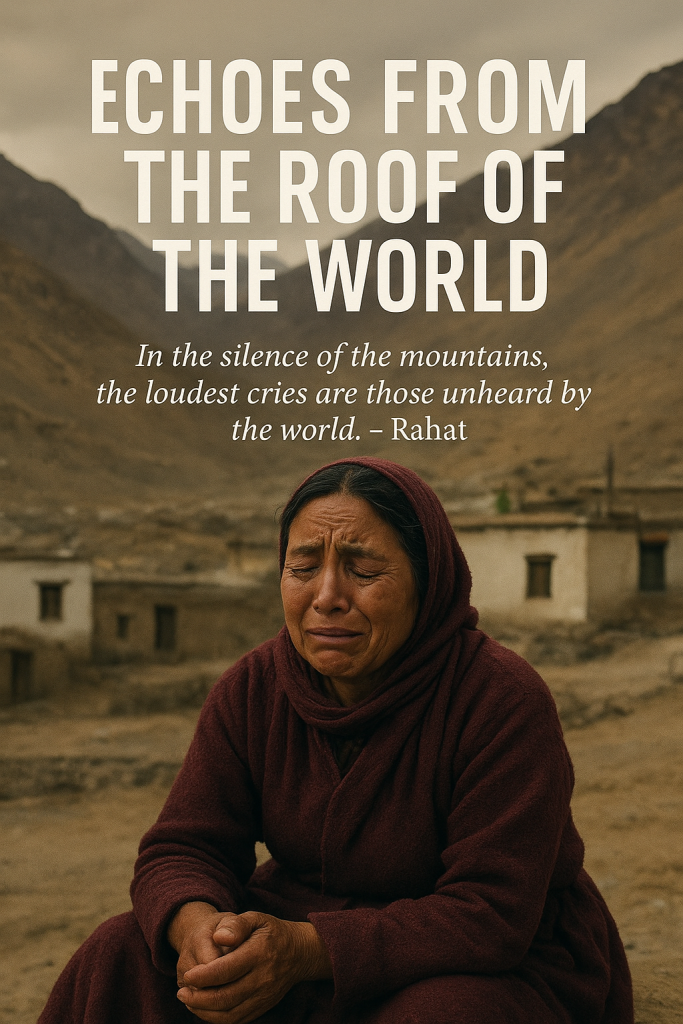
All Categories
Recent Posts
The Bhartiya Ladhakhi:Echoes From The Roof Of The World
DOGRA’s
The Unheard Question: What Next After The Floods Of 2025 (Part 2)
07316984833
contactus@tucsi.org

